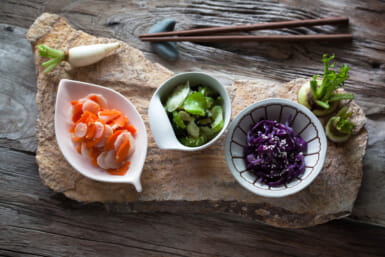In an economy that is still struggling, Japanese farmers have relied on their green thumb to grow luscious and lavishly tended fruit that still fetch high prices.
From square shaped watermelons, perfectly round peaches, and plump grapes, Japan has mastered the art of growing luxurious fruit.
These top-notch fruit are not just well shaped, they boast a taste that fans say is better than anything else—all for a price.
Canteloupe melons grown in the north of Hokkaido can sell for the price of a new car. A pair fetched a cool 1.6 million yen in an auction in May.
A single bunch of “Ruby Roman” grapes reportedly sold for 400,000 yen ($4,000): that’s 11,000 yen per grape.
Despite the hefty prices, demand for the top shelf fruit has been consistently strong.
Sun Fruits, a chain of fruit boutiques, has every luxurious fruit you could ask for, except for anything below 30,000 yen.
Yoshinobu Ishiyama, manager of a branch of Sun Fruits at Tokyo Midtown, says well-heeled customers come to the store for their fruit and give them as seasonal gifts.
“Most of our products are for gift purposes, so we collect large and high-grade products from all around Japan,” says Ishiyama.
“We offer rare products. Above all, they have to be delicious,” he says.
Inside the boutique, located at an upscale commercial complex, shelves of extravagant fruit line the store.
A single white peach—perfectly round and about the size of a newborn baby’s head—goes for 2,635 yen. Square watermelons, which are grown in plastic boxes and usually used for decoration, cost as low as 5,000 yen. A bunch of Muscat of Alexandria grapes sells for 7,350 yen. Musk melons, a traditional Japanese gift, cost 16,000 yen.
Sun Fruits provides a “premium” fruit shopping experience, with soothing music and presentation to draw in customers.
“You buy these delicious things and share a great time with people who are close to you,” said Farhad Kardan, a Tokyo-based corporate trainer who was strolling the aisles.
“You never forget the experience of having eaten something so delicious. What you pay for is for the quality and the value,” he said.
By: Maesie Bertumen
Image: Sebra / Shutterstock.com









